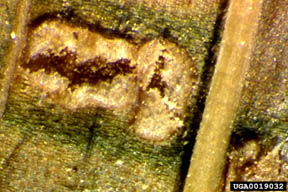Invasive Species Spotlight: Gladiolus Rust (Uromyces transversalis) | |
|---|---|
| August 7, 2008 | |
|
Rust fungi come in many forms. Arborists in the Midwest have been very familiar with the cedar–apple and hawthorn rust, which have been detrimental to many ornamental and fruit-producing trees. Recently, farmers are becoming familiar with soybean rust, as it has been found in several soybean-producing areas. All of these forms of rust are host specific, can reduce the yield of a crop, cause stress to the plants, and leave unsightly foliar infections. The latest of these emerging plant pathogens has been damaging one of America’s favorite ornamental flowers, the gladiolus (Gladiolus spp.). Like most rust fungi, gladiolus rust can first be identified by the small yellow spots that form on either side of the leaves of the plant. These spots eventually develop into orange-colored pustules; these may be up to 3 mm long each, typically elongated across the width of the leaves.  Gladiolus rust was first detected in the United States in 2006 in several locations. The first was in Florida in April in a gladiolus-production farm; it was later found in another production farm in May. That same year, the rust was found in San Diego, California, on one gladiolus farm and two residential areas. It has since been identified in 2007 and 2008 in isolated areas within horticultural production facilities. The primary pathways of gladiolus rust are through plants and cut flowers. Spores on the leaf surface are easily dispersed by wind or lightly brushing infected plants; spores can travel long distances in the air. However, the movement of cut flowers is also an important method of dissemination, as confirmed by the number of interceptions from commercial shipments and passenger baggage at ports-of-entry. The rust is believed to come from southern Africa, which is also the origin of many ornamental gladiolus plants. While the rust so far seems to quickly attack gladiolus species, other plants in the Iris family (Iridaceae) could also be at risk, including Tritonia, Crocosmia, and Watsonia species. Gladiolus rust is not established in the United States, but it has been introduced and detected, with eradication efforts now in place. More information can be found at http://www.aphis.usda.gov/plant_health/plant_pest_info. To learn more, go to the Illinois CAPS blog (www.illinoiscapsprogram.blogspot.com) for all the latest news on invasive pests in Illinois. (Kelly Estes and Mike Garrett) | |
| Author: | Nancy Pataky |

